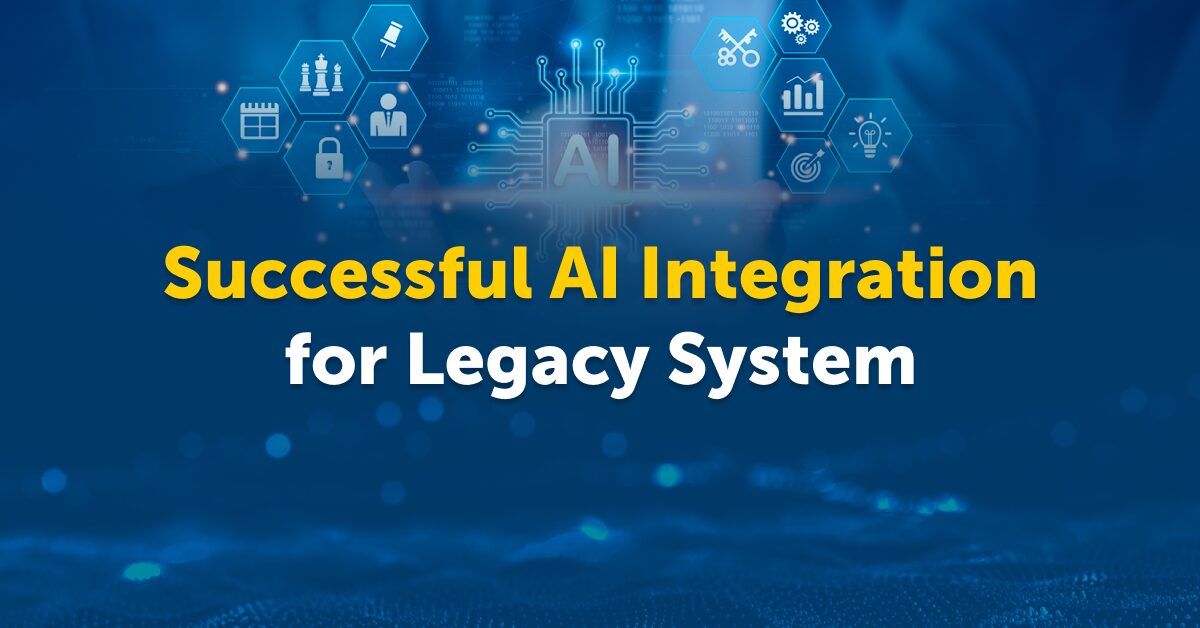From Vision to Execution: A CTO’s Guide to Successful AI Adoption

As a CTO, you understand the transformative potential of AI to drive innovation and gain a competitive advantage. However, the path to successful AI adoption is complex. You must align stakeholders, assemble the right talent, choose technologies that match your needs, and implement responsible practices. This roadmap provides guidance for your AI journey.
Drawing on insights from CTOs across industries, we address your challenges and concerns to help you translate an AI vision into reality. You will learn strategies to align AI with business objectives and build an AI-ready organization. We’ll also explore steps to evaluate and select AI solutions and measure their impact to maximize ROI. With the right plan and preparation, you can harness the power of AI to shape the future of your company. The time for AI is now.
Aligning AI Strategies With Business Goals: How CTOs Can Drive Value
To successfully deploy AI, CTOs must align AI strategies with business goals. This requires identifying high-value use cases, assessing infrastructure needs, and determining required talent and skills.
High-Value Use Cases
Focus on challenges that significantly impact customer experience, operational efficiency, or business growth. For example:
- Improving customer service through chatbots and virtual agents
- Optimizing supply chain management with predictive demand forecasting
- Enhancing cybersecurity using machine learning for threat detection
Infrastructure Assessment
Evaluate whether current data, processing power, and tools can support target use cases. CTOs may need to invest in:
- Centralized data lakes and improved data quality/governance
- Scalable compute, especially GPUs, for intensive model training
- Automated machine learning platforms to accelerate model development
Talent Requirements
Build an AI team with a mix of business and technical skills. Key roles include:
- Data scientists to identify patterns and build models
- Data engineers to construct data pipelines and ensure quality
- ML engineers to translate models into applications
- Subject matter experts to help apply AI to complex business challenges
By aligning AI strategies with business priorities, investing in the right infrastructure, and hiring top talent, CTOs can set their organizations up for success and gain a competitive advantage. With a thoughtful, well-designed approach, artificial intelligence can become a key driver of value creation.
Click here to explore the how Fusemachines transforms businesses with its expert AI solutions. To schedule a complimentary consultation today, click here.
Building an AI Team: Recruiting, Training, and Retaining Top Talent
To successfully implement AI, you need the right people with the right skills. As CTO, one of your key responsibilities will be attracting, developing, and retaining AI talent.
When recruiting AI professionals, look for candidates with experience in machine learning, deep learning, natural language processing, and data science. While technical skills are important, also assess soft skills such as communication, creativity, and critical thinking. A mix of backgrounds and perspectives will benefit your team.
Provide ongoing training and education for your AI team. Send key team members to industry conferences and events to stay up-to-date with advancements. Offer internal mentorship programs where more senior data scientists coach and guide junior members. Most importantly, give your team opportunities to continually enhance their skills through online courses and hands-on experience.
Retaining top AI talent is challenging given the high demand. Beyond competitive compensation and benefits, focus on creating an engaging work environment. Give your team autonomy over projects, allow for flexible work schedules, and provide opportunities for career growth. Recognize and reward the contributions of team members.
Selecting the Right AI Technologies: Navigating Options and Avoiding Pitfalls
As a CTO looking to adopt AI, you must evaluate your organization’s needs and determine which technologies will address them. Consider whether you require solutions for automation, predictive analytics, computer vision, natural language processing, or other applications. Some things to consider:
- Robotic process automation (RPA) to automate repetitive, routine tasks. RPA is easy to implement but limited to rule-based processes.
- Machine learning models for predictive analytics and pattern recognition. ML requires data and time to train but can yield impactful insights.
- Computer vision for image and video analysis. CV is ideal for applications like facial recognition, object detection, and self-driving vehicles but often needs massive datasets.
- Natural language processing (NLP) for analyzing unstructured text data. NLP powers applications like chatbots, sentiment analysis, and document summarization but can be complex to develop and train.
Evaluate Your Needs and Options
Evaluate each technology based on priorities like cost, implementation timeframe, required expertise, data and computing needs, and risk. Some options may be quick to implement but limited in capability, while others offer more advanced functionality but require significant investments of resources to develop and deploy.
Consider starting with more straightforward technologies to build internal experience before progressing to more complex solutions. You can then determine whether to build in-house capabilities, work with third-party vendors, or adopt pre-built platforms and tools. The right approach depends on your timeline, budget, and available talent and resources.
With many options available, it’s important to select technologies aligned with priorities and start with solutions that will achieve quick wins to gain buy-in for expanding your AI initiatives. But avoid being tempted by hype—focus on solving actual business problems to drive measurable impact. The ultimate goal is not just adopting AI for AI’s sake but leveraging it to enhance products, optimize processes, reduce costs, and improve customer experiences.
Click here to explore the how Fusemachines transforms businesses with its expert AI solutions. To schedule a complimentary consultation today, click here.
Ensuring Responsible AI Practices: Ethics, Bias Mitigation, and Compliance
To ensure your AI systems are deployed and used responsibly, focus on ethics, bias mitigation, and compliance.
Ethics
Establish an ethics policy and review board to assess the impact of your AI systems and set guidelines. Consider how the technology may affect privacy, security, and bias. Provide regular ethics training for your technical and non-technical teams.
Bias Mitigation
Test your AI systems rigorously to uncover unintended biases, especially for sensitive attributes like gender, ethnicity, age, and disability status. Examine how the systems perform for different groups and make corrections to address disparities. Develop diverse, inclusive teams to minimize built-in biases.
Compliance
Stay up-to-date with laws and regulations on AI like GDPR, CCPA, and sector-specific policies. Conduct privacy impact assessments to identify and address risks. Be transparent about how personal data is collected and used. Allow individuals some level of consent and control over their data. To measure the impact of your AI ethics and compliance efforts, track key performance indicators such as:
- Number of ethics reviews and recommendations implemented
- Hours of ethics and bias training completed by teams
- Number of bias tests performed and issues remediated
- Percentage of AI systems compliant with regulations
- Number of privacy requests received and fulfilled
By prioritizing responsible practices, you can build trust in your AI technologies and ensure they are fair, transparent, and accountable. Continually re-evaluating and strengthening your policies and procedures will help enable the safe, ethical development of AI.
Measuring ROI and Tracking Success: Quantifying the Impact of AI Initiatives
To determine the success and return on investment (ROI) of your AI initiatives, establishing key performance indicators (KPIs) and benchmarks early on is essential. As CTO, you must define quantifiable metrics to measure both short-term wins and long-term impact. Some recommendations:
Align KPIs with Business Goals
Select KPIs that directly map to your key business objectives for implementing AI, e.g. increasing operational efficiency by X%, improving customer satisfaction scores by Y points, reducing costs by Z% annually. This ensures your AI systems are optimized to drive real value.
Track Productivity and Efficiency Gains
Measure improvements on metrics such as processing times, output volume, error rates reduction, and employee productivity. For example, if AI streamlines a manual data entry process, track entries per employee per hour before and after implementation.
Monitor Customer Experience Improvements
Use surveys, ratings, reviews, and customer support analytics to quantify AI’s impact on customer experience. Look for increases in satisfaction and Net Promoter Scores, decreases in complaint rates, and improvements in resolution times.
Calculate Cost Savings and Avoidance
Add up reductions in expenses, waste, and resource usage. Also track costs avoided by preventing issues AI helps identify, such as fraud detection saving potential loss. Compare overall costs of development and maintenance to cost benefits.
Review and Revise
Regularly revisit your KPIs and metrics to ensure they remain relevant and continue providing actionable insights. Be prepared to revise or replace those no longer aligned with your goals or providing value. AI is a fast-moving field, so consistent monitoring and adaptation is important. With the right KPIs and tracking in place, CTOs can gain valuable insights into how AI enhances business performance, productivity, customer relationships, risk management, and cost structures. Measuring ROI ultimately demonstrates AI’s transformation from vision to execution.
Bottom Line
Adopting AI in your organization is a journey that requires vision, patience, and perseverance. As CTO, you must set a bold and thoughtful AI vision, build internal support, and empower your team to execute responsibly. With the right strategic roadmap tailored to your industry’s unique dynamics, AI can drive real business outcomes and maintain your competitive edge. Though the path is challenging, the rewards of enhanced insights, optimized processes, and new opportunities for growth make AI a transformative force no organization can afford to ignore. You now have the insights and guidance to make that vision a reality.
Click here to explore the how Fusemachines transforms businesses with its expert AI solutions. To schedule a complimentary consultation today, click here.


